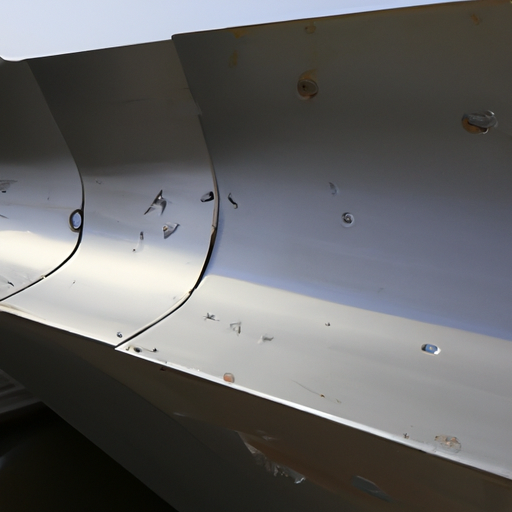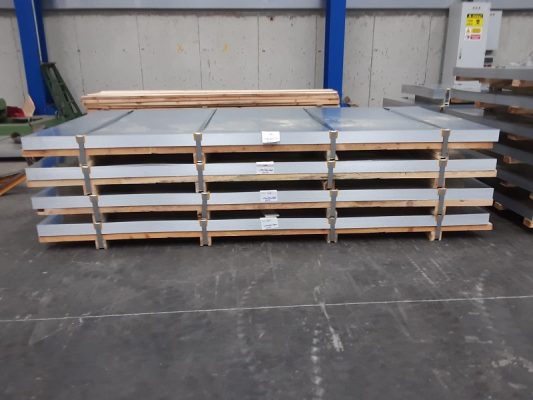-
Table of Contents
- Introduction
- The Corrosion Resistance of Stainless Steel in Shipbuilding
- The Benefits of Using Stainless Steel in Ship Construction
- The Environmental Impact of Using Stainless Steel in Shipbuilding
- The Cost-Effectiveness of Stainless Steel in Shipbuilding
- Exploring the Durability of Stainless Steel in Shipbuilding
“The Strength of the Sea: The Durability of Stainless Steel in Shipbuilding.”
Introduction
The life of stainless steel used in the construction of ship materials is an important factor to consider when building a ship. Stainless steel is a strong and durable material that is resistant to corrosion and rust, making it an ideal choice for shipbuilding. It is also relatively lightweight, making it easier to transport and install. The life of stainless steel used in shipbuilding depends on a variety of factors, including the environment in which it is used, the type of steel used, and the maintenance and care taken to ensure its longevity. This article will discuss the life of stainless steel used in shipbuilding and the factors that affect its longevity.
The Corrosion Resistance of Stainless Steel in Shipbuilding
The use of stainless steel in shipbuilding has become increasingly popular due to its superior corrosion resistance. Stainless steel is an alloy of iron, chromium, and other metals that provides superior corrosion resistance compared to other metals. This corrosion resistance is due to the formation of a thin, protective chromium oxide layer on the surface of the steel. This layer is self-repairing and can withstand harsh marine environments.
The corrosion resistance of stainless steel in shipbuilding is determined by its composition and the environment in which it is used. The most common stainless steel used in shipbuilding is the austenitic type, which contains at least 18% chromium and 8% nickel. This type of stainless steel is highly resistant to corrosion in both fresh and salt water. It is also resistant to pitting and crevice corrosion, which are common forms of corrosion in marine environments.
In addition to its corrosion resistance, stainless steel is also highly durable and can withstand extreme temperatures and pressures. It is also resistant to abrasion and impact, making it an ideal material for shipbuilding. Stainless steel is also non-magnetic, which is important for navigation and communication systems.
The corrosion resistance of stainless steel in shipbuilding is further enhanced by the use of protective coatings. These coatings provide additional protection against corrosion and can be applied to the steel before or after installation. The most common coatings used in shipbuilding are epoxy, polyurethane, and vinyl.
In conclusion, stainless steel is an ideal material for shipbuilding due to its superior corrosion resistance, durability, and non-magnetic properties. Its corrosion resistance is further enhanced by the use of protective coatings. With proper maintenance and care, stainless steel can provide long-term protection against corrosion in marine environments.
The Benefits of Using Stainless Steel in Ship Construction
The use of stainless steel in ship construction has become increasingly popular in recent years due to its many benefits. Stainless steel is a strong, durable, and corrosion-resistant material that is ideal for use in the marine environment. It is also relatively lightweight, making it an ideal choice for shipbuilding.
One of the primary benefits of using stainless steel in ship construction is its strength and durability. Stainless steel is highly resistant to corrosion, making it an ideal choice for ships that will be exposed to saltwater and other harsh elements. It is also highly resistant to abrasion, making it an ideal choice for ships that will be exposed to heavy use. Additionally, stainless steel is highly resistant to fire, making it an ideal choice for ships that will be exposed to high temperatures.
Another benefit of using stainless steel in ship construction is its low maintenance requirements. Stainless steel is highly resistant to corrosion, meaning that it does not require frequent maintenance or repairs. This makes it an ideal choice for ships that will be exposed to harsh elements for long periods of time. Additionally, stainless steel is relatively easy to clean and maintain, making it an ideal choice for ships that will be exposed to dirt and debris.
Finally, stainless steel is an environmentally friendly material. It is highly recyclable, meaning that it can be reused and repurposed for other applications. Additionally, stainless steel does not contain any toxic chemicals or materials, making it an ideal choice for ships that will be exposed to the environment.
Overall, the use of stainless steel in ship construction has many benefits. It is a strong, durable, and corrosion-resistant material that is ideal for use in the marine environment. It is also relatively lightweight, making it an ideal choice for shipbuilding. Additionally, stainless steel is highly resistant to corrosion, abrasion, and fire, making it an ideal choice for ships that will be exposed to harsh elements. Finally, stainless steel is an environmentally friendly material that is highly recyclable and does not contain any toxic chemicals or materials.
The Environmental Impact of Using Stainless Steel in Shipbuilding
The use of stainless steel in shipbuilding has become increasingly popular in recent years due to its many advantages. Stainless steel is a corrosion-resistant alloy that is strong, durable, and lightweight, making it an ideal material for shipbuilding. It is also highly resistant to fire and heat, making it a safe choice for ships that may be exposed to extreme temperatures. Additionally, stainless steel is easy to clean and maintain, making it a cost-effective choice for shipbuilders.
However, the use of stainless steel in shipbuilding also has some environmental impacts. The production of stainless steel requires the use of energy and resources, which can lead to air and water pollution. Additionally, the production of stainless steel can generate hazardous waste, such as slag, which can be difficult to dispose of safely.
The use of stainless steel in shipbuilding can also lead to the release of hazardous chemicals into the environment. Stainless steel is often coated with a protective layer of paint or other chemicals to protect it from corrosion. These chemicals can leach into the environment, potentially contaminating water sources and harming wildlife.
Finally, the use of stainless steel in shipbuilding can lead to the release of greenhouse gases. The production of stainless steel requires the use of energy, which can lead to the release of carbon dioxide and other greenhouse gases. Additionally, the use of stainless steel in shipbuilding can lead to the release of volatile organic compounds, which can contribute to air pollution.
Overall, the use of stainless steel in shipbuilding has many advantages, but it also has some environmental impacts that must be taken into consideration. Shipbuilders should take steps to reduce their environmental impact by using energy-efficient production methods and disposing of hazardous waste safely. Additionally, they should ensure that any chemicals used to coat stainless steel are not released into the environment. By taking these steps, shipbuilders can ensure that their use of stainless steel is as environmentally friendly as possible.
The Cost-Effectiveness of Stainless Steel in Shipbuilding
The use of stainless steel in shipbuilding has become increasingly popular in recent years due to its cost-effectiveness and durability. Stainless steel is a corrosion-resistant alloy of iron, chromium, and other metals that is highly resistant to rust and corrosion. It is also highly resistant to abrasion and wear, making it an ideal material for shipbuilding.
The cost-effectiveness of stainless steel in shipbuilding is due to its low cost and long-term durability. Stainless steel is relatively inexpensive compared to other materials used in shipbuilding, such as aluminum and steel. Additionally, stainless steel is highly resistant to corrosion, which means that it will not need to be replaced as often as other materials. This reduces the cost of maintenance and repairs, as well as the cost of replacement parts.
The durability of stainless steel also makes it an ideal material for shipbuilding. Stainless steel is highly resistant to abrasion and wear, meaning that it will not need to be replaced as often as other materials. This reduces the cost of maintenance and repairs, as well as the cost of replacement parts. Additionally, stainless steel is highly resistant to corrosion, which means that it will not need to be replaced as often as other materials.
The use of stainless steel in shipbuilding also has environmental benefits. Stainless steel is a recyclable material, meaning that it can be reused and recycled, reducing the amount of waste produced during the shipbuilding process. Additionally, stainless steel is non-toxic and does not release any hazardous chemicals into the environment, making it a safe and environmentally friendly material for shipbuilding.
Overall, the cost-effectiveness and durability of stainless steel make it an ideal material for shipbuilding. Its low cost and long-term durability make it an economical choice, while its environmental benefits make it a safe and sustainable choice. As such, stainless steel is an excellent choice for shipbuilding and is likely to remain a popular choice for many years to come.
Exploring the Durability of Stainless Steel in Shipbuilding
Stainless steel has become an increasingly popular material for shipbuilding due to its durability and corrosion resistance. This material is used in a variety of applications, from hulls and decks to masts and rigging. In this article, we will explore the durability of stainless steel in shipbuilding and how it can benefit the industry.
Stainless steel is a strong and durable material that is resistant to corrosion and rust. This makes it an ideal choice for shipbuilding, as it can withstand the harsh conditions of the sea. The material is also lightweight, which makes it easier to work with and reduces the overall weight of the ship. Additionally, life of the stainless steel is highly resistant to fire, making it a great choice for fire-resistant vessels.

The durability of stainless steel in shipbuilding is further enhanced by its ability to resist abrasion. This means that the material can withstand the wear and tear of the sea without losing its strength or integrity. This makes it an ideal choice for vessels that are exposed to rough seas or frequent use.
The corrosion resistance of stainless steel also makes it a great choice for shipbuilding. This material is able to withstand the corrosive effects of saltwater, which can cause damage to other materials. This makes it a great choice for vessels that are exposed to saltwater on a regular basis.
Finally, stainless steel is also highly resistant to temperature changes. This makes it an ideal choice for vessels that are exposed to extreme temperatures, such as those found in the Arctic or Antarctic. This makes it a great choice for vessels that are used in these regions.
Overall, stainless steel is an ideal choice for shipbuilding due to its durability, corrosion resistance, and resistance to temperature changes. This material is able to withstand the harsh conditions of the sea and is highly resistant to fire, abrasion, and corrosion. This makes it an ideal choice for vessels that are exposed to the elements on a regular basis.
